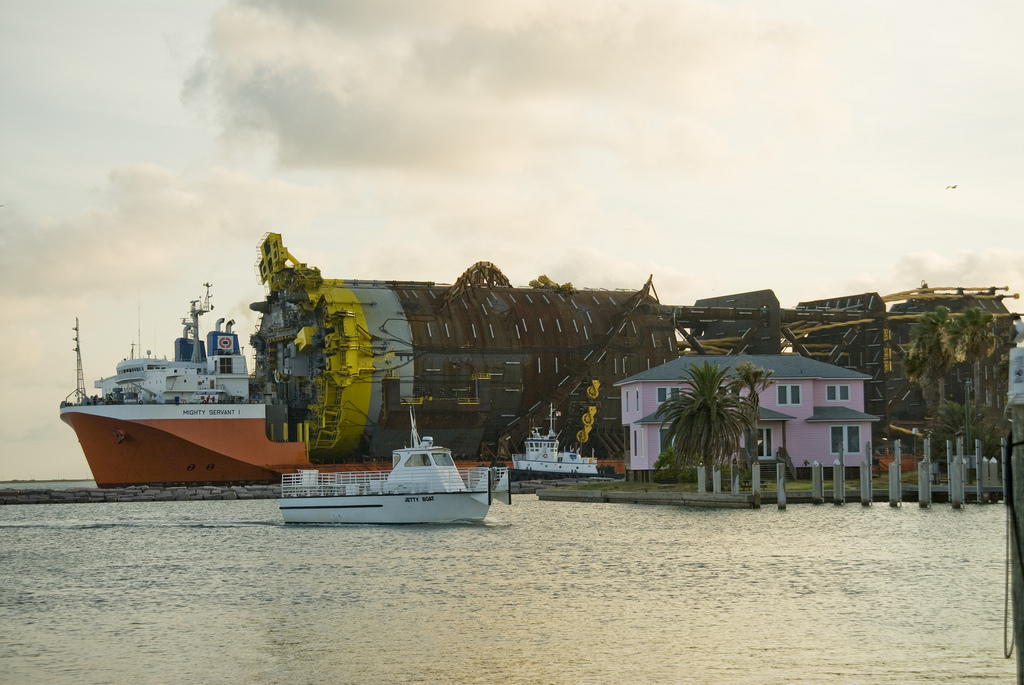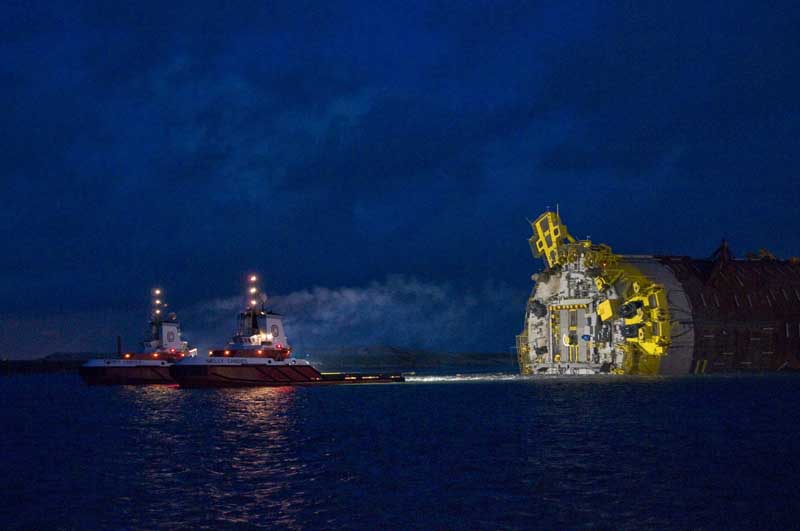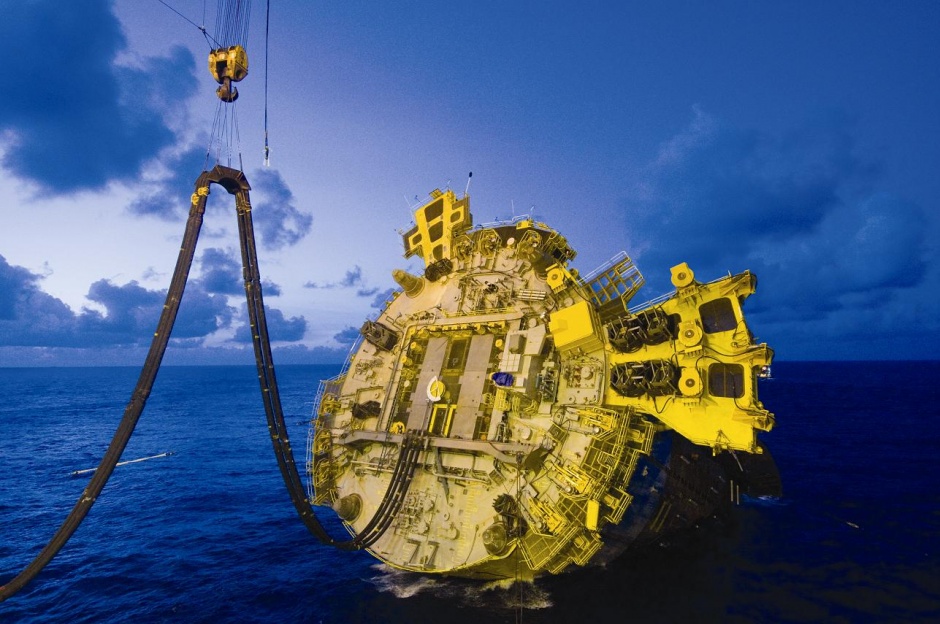World records don’t stand for long in the frontier-busting business of deep-sea oil and gas, but when Shell’s Perdido platform goes online early next year, it will, for a while at least, be the deepest drilling and production facility on the planet.

Situated 200 miles offshore in the relatively untapped Western belt of the Gulf of Mexico, Perdido — which is co-owned by Shell, BP and Chevron — is expected to produce around 100,000 barrels of oil and 200,000ft3 of gas per day. Operating in water that’s 7,500ft deep and tapping into oil and gas reservoirs that lie a further 8,000ft beneath the seabed, the heart of the facility is a 50,000 ton, 555ft-long spar — a giant, floating cylinder that was, last summer, towed 13,200km from its construction site in Finland, upended in the water and tethered to the seabed with nine strong polyester mooring lines. This summer, the ‘topside’, containing living quarters and production equipment, was mounted on the Spar.
The size of the structure, the hurricanes that lash this area of the ocean, the depth at which it’s operating and the properties of the reservoir itself, have presented Shell’s engineers with a series of challenges that not so long ago would have been seen as insurmountable.
According to Perdido development venture manager, Bill Townsley, the technology to exploit the resource didn’t even exist when Shell first started eyeing up the site. ‘We purchased the Perdido leases in 8,000ft of water in 1996 when the industry was only able to develop between 2,000 and 3,000ft of water,’ he said. Since then, the developments have come thick and fast, pushing back the boundaries of what’s possible in deep water and laying the foundations for the many other projects that hope to tap into the Gulf of Mexico’s potentially vast subsea reserves. These include BP’s recently discovered Tiber prospect, which some experts claim may contain up to three billion barrels of oil.
According to Townsley, one of the big challenges of the project is that the pressure of the oil and gas in the reservoir makes it doubly hard to get at. ‘Those reservoirs are what we call normally pressured… a lot of the other deep-water developments in the eastern Gulf of Mexico are geo-pressured or higher pressured.’

This led to the development of a subsea boosting and separation system, which, as well as pumping the resource to the surface, also carries out some processing on the seabed, a new approach for the offshore industry. ‘In order to get the oil to flow to the surface, we needed some form of artificial lift,’ said Townsley. ‘The way that this would normally be done would be to put a submersible pump in every bore and have all those wells tied to the surface, and there’s no way we could build a facility at the size and expense’.
Instead, Townsley’s team opted to use the sea floor as part of the facility and installed a series of manifolds on the seabed that collect the oil and gas from the wells and feed it through to a number of subsea boosting systems. 22 of these wells lie beneath the spar, while a further 13 outlying wells about eight miles due west of the platform also link into the manifolds. These include the 9,627ft (2,934m) Tobago well, the world’s deepest subsea well.
When it arrives at the boosting system, the oil and gas mixture is subjected to a cyclonic separation process. While the gas is routed into the outer section of the riser pipe and sent to the surface, the liquid goes into a sump sunk 300ft below the sea level, from where a 1,500hp electrical submersible pump sends it to the surface. It is, said Townsley, an approach that makes the uneconomical economical. ‘This whole system allows us to co-mingle our production on the sea floor. We have 22 wells underneath the spar and we only need five pumps to take the production to the surface, instead of what in the past would have been 22 pumps,’ he added.
By adjusting the tension on its mooring lines, the spar can move around an area of water equivalent to the size of a football pitch and position itself directly above any of these 22 wells. Townsley said that this also enables the platform to adopt a safe position in the event of a storm.
Once the oil and gas have been bought to the surface and processed further, the other big challenge of deepwater production kicks in: getting it back the 200 miles or so to dry land. ‘On the Eastern Gulf there is pipeline highway that you can tie your production into,’ said Townsley. ‘But on the Western belt there isn’t that much. The only one that was there was about 70 miles away but… it had no place for us to tie into and where we wanted to tie in happened to be in 4,500ft of water.’

The solution, he said, was arrived at through a groundbreaking application of subsea robotics technology. First, the existing pipeline was shut down and, to prevent oil escaping into the sea, flushed through with pigs — spherical structures designed for exactly this purpose. A specially designed jig was lowered to the sea floor and carefully placed over the 18in-diameter pipeline by a remotely operated vehicle (ROV). An additional ROV, equipped with a saw, then placed on the jig, cut a section from the pipe and lifted it to the surface. Finally, ROVs were used to install three tie-in pieces that enabled Perdido to connect to the pipeline. The whole process, which took 17 days, is yet another example, said Townsley, of advanced technology making the previously unachievable possible.
With many of the world’s largest oil companies keen to exploit the planet’s deep-water reserves, Townsley believes such breakthroughs could be key to future explorations. ‘I think the industry interest in this technology is tremendous — there will be some direct applications for this, but then it will evolve. The ability for this technology to really shrink the size of what we need at the surface is really the part that the industry will grab onto. Without these developments in technology,’ he added, ‘we’d still be sitting there looking at it.’
Drilling down - Pushing the boundaries of deep-water drilling and production
- Operating in 7,817ft of water, Perdido is the deepest drilling and production facility in the world
- It will access 35 subsea wells and produce 130,000 barrels of oil equivalent per day
- 550ft long and 118ft in diameter, the Spar is almost the same size as the Eiffel tower
- It will take oil and gas from the Tobago well, at 9,267ft the world’s deepest producing subsea well
- Perdido’s engineers used robots to achieve the deepest ever pipeline cut and tie-in at 5,000ft water depth












Comment: Engineers must adapt to AI or fall behind
A fascinating piece and nice to see a broad discussion beyond GenAI and the hype bandwagon. AI (all flavours) like many things invented or used by...